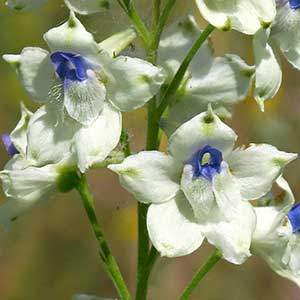Delphinium nuttallii subsp. ochroleucum
(synonym of Delphinium leucophaeum)
Delphinium variegatum
pale larkspur, white rock larkspur
royal larkspur
30-60 cm.
(10-)20-50(-80) cm;
base reddish or not, not longitudinally ridged, long-pubescent.
blade round to pentagonal, 1-4.5 × 2-6 cm, pubescent; ultimate lobes 3-15, width 3-8 mm (basal), 2-5 mm (cauline).
(4-)6-17(-20)-flowered, open;
pedicel 0.5-3(-7) cm, usually puberulent;
bracteoles 2-7(-23) mm from flowers, green, linear-lanceolate, 3-8 mm, puberulent.
sepals white or light yellow, spurs 9-11 mm;
lower petal blades 4-6 mm.
sepals usually deep royal blue, sometimes bright blue to light blue or white, ± finely pubescent, lateral sepals spreading, 10-18(-25) × 6-10 mm, spurs straight, ascending ca. 30° above horizontal, 10-19 mm;
lower petal blades slightly elevated, ± exposing stamens, 4-11 mm, clefts 0.5-3.5 mm;
hairs sparse, more on inner lobes than outer lobe or centered, scattered on margins, white or yellow.
9-19 mm, 2.2-3.8 times longer than wide, ± puberulent.
not echinate, appearing ± smooth to naked eye;
seed coat cells with margins ± undulate, surfaces roughened.
= 16.
Delphinium nuttallii subsp. ochroleucum
Delphinium variegatum
Of conservation concern.
The range of morphologic features of Delphinium nuttallii subsp. ochroleucum (D. leucophaeum) is almost completely encompassed within that of D. nuttallii subsp. nuttallii. Sepal color is the only feature consistently separating the two subspecies. Were it not for the fact that any given population typically has plants of only one flower color, a rank of forma would be more appropriate.
(Discussion copyrighted by Flora of North America; reprinted with permission.)
Subspecies 3 (3 in the flora).
(Discussion copyrighted by Flora of North America; reprinted with permission.)
1. Long hairs dense on base of stem; sepals usually deep royal blue; mainland. | subsp. variegatum |
1. Long hairs sparse on proximal portion of stems; sepals white to bright blue; islands. | → 2 |
2. Sepals bright blue to light blue. | subsp. thornei |
2. Sepals white to light blue. | subsp. kinkiense |


